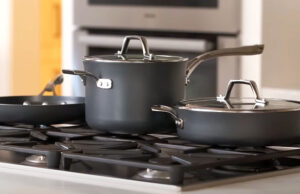As an Amazon Associate, I earn from qualifying purchases at no extra cost to you.
How Much Electricity Does an Oven Use? Expert Guide
When you’re cooking your favorite meals or baking treats, have you ever wondered how much electricity your oven uses? Whether you have a gas or electric oven, it’s important to know how much power it consumes, especially when it comes to your monthly energy bills. In this easy guide, we’ll break it down for you! We’ll explain the factors that affect your oven’s electricity use and offer tips to help you save energy while still making delicious dishes. Let’s get started!
What Determines the Electricity Usage of an Oven?
Understanding how much electricity an oven uses starts with knowing what affects its energy consumption. There are several key factors that influence the power your oven draws, and they can vary from one model to another. The type of oven, its size, and its energy efficiency all play a role in how much electricity is used during cooking. The first step to understanding your oven’s electricity usage is looking at the power rating, which is usually listed in watts.
Oven Type and Power Rating
Electric ovens typically use between 1,000 to 5,000 watts of power, with most models falling between 2,000 and 3,500 watts. The more powerful the oven, the faster it can reach high temperatures, which can help cut down cooking time. If you have a smaller or more energy-efficient oven, it will use less electricity compared to a larger, more powerful model. Gas ovens use electricity only to power their controls, lights, and ignition system, which makes their power usage much lower than electric ovens.
Size of the Oven
The size of the oven matters when it comes to energy usage. Larger ovens, like double wall ovens, need more electricity to heat up compared to smaller models, as they have more space to warm. On the other hand, smaller ovens, like toaster ovens, consume less electricity since they have a smaller cooking area to heat up. If you often cook in large batches or need extra space for big meals, a larger oven might be necessary, but it will use more energy.
Energy Efficiency of Your Oven
The energy efficiency of an oven is an important factor in how much electricity it uses. Older ovens or less efficient models tend to waste more heat and take longer to cook food, which means they use more electricity. In contrast, modern ovens are often designed with better insulation and advanced technology to help keep the heat inside and reduce power usage. If your oven has an “Energy Star” rating, it’s a sign that it meets specific energy efficiency standards.
Temperature and Cooking Time
Another important factor is how long you use the oven and at what temperature. The higher the temperature, the more electricity the oven needs to maintain that heat. If you’re cooking at lower temperatures for long periods, your oven will use less energy. For example, roasting vegetables at 350°F uses less electricity than baking a cake at 450°F for 15 minutes. It’s a good idea to adjust cooking times and temperatures to avoid overusing energy unnecessarily.
How Much Does It Cost to Run an Oven?
Now that we know what determines an oven’s electricity usage, let’s look at how much it costs to run one. The cost of running an oven depends on the electricity rates in your area, how often you use your oven, and how long you cook for. By understanding these costs, you can better manage your energy bills and avoid any surprises.
Calculating the Cost of Running an Electric Oven
To calculate how much it costs to run your electric oven, you need to know two things: the power rating (in kilowatts) and the amount of time you use it. Here’s how you can figure out the cost:
- Find the power rating of your oven (usually in watts). If it’s in watts, divide it by 1,000 to convert it to kilowatts.
- Multiply the kilowatts by the number of hours you use the oven.
- Multiply that by your local electricity rate (usually in kilowatt-hours, kWh).
For example, if your oven uses 3,000 watts (3 kW) and you use it for 2 hours, the total energy consumption will be:
3 kW × 2 hours = 6 kWh
Now, if your electricity rate is $0.12 per kWh, the cost to run your oven for 2 hours will be:
6 kWh × $0.12 = $0.72
So, it costs about 72 cents to run your oven for 2 hours. Of course, this will vary depending on your oven’s power rating and your electricity rates, but this simple calculation gives you a good idea of how much it costs to use your oven.
How Often Do You Use Your Oven?
If you only use your oven occasionally, your monthly electricity bill won’t be as affected as much as if you use it every day. For example, if you bake once a week, you’ll be using your oven much less than someone who bakes and cooks dinner every night. If you want to track how much you’re spending on your oven, consider checking your electric bill and comparing the usage from month to month.
Tips to Save Electricity When Using an Oven
Now that you know how much electricity your oven uses and how to calculate the cost, let’s look at some ways to reduce energy consumption while still enjoying your cooking. Saving electricity doesn’t mean you have to stop using your oven entirely. With a few simple tips, you can cut down on your energy usage and still make tasty meals.
Cook in Batches
Instead of cooking small portions of food every day, consider cooking in batches. By cooking larger meals and storing leftovers, you’ll use your oven less often and reduce the amount of energy you consume. For example, roast a big batch of vegetables or bake multiple meals at once to save time and electricity. This is especially helpful if you’re cooking for a family or hosting a dinner party.
Preheat Only When Necessary
Many people preheat their ovens before every cooking session, but it’s not always necessary. If you’re baking a dish that doesn’t require precise timing or temperature control, you can skip the preheating step. However, for baking delicate items like cakes or pastries, preheating is still important to ensure even cooking. For other dishes, you can save energy by putting your food in the oven while it’s still heating up.
Use the Right Size Oven
If you’re only cooking for one or two people, consider using a smaller oven or even a toaster oven. These use less electricity because they have a smaller space to heat up. Plus, they can reach high temperatures more quickly, reducing cooking time and energy usage. When cooking larger meals, a regular oven might be necessary, but for smaller tasks, smaller ovens can save energy.
Keep the Oven Door Closed
Every time you open the oven door, you let heat escape, which causes the oven to work harder to maintain the temperature. This means more energy consumption. Try to resist the urge to peek inside, especially during longer cooking times. If you do need to check on your food, try to open the door as briefly as possible to minimize heat loss.
Use Cookware That Conducts Heat Well
The type of cookware you use can also impact energy consumption. Cookware made of materials like glass, ceramic, or cast iron are excellent at retaining heat. This means your oven doesn’t need to work as hard to maintain a consistent temperature. When selecting bakeware, choose those that conduct heat efficiently and allow for faster cooking times.
I hope this article helped you understand how much electricity an oven uses and gave you some practical tips on saving energy while cooking. By being mindful of your cooking habits and using energy-efficient appliances, you can enjoy your favorite meals without worrying about high energy bills. Happy cooking!
Frequently Asked Questions
Is it better to use a smaller oven to save electricity?
Yes, smaller ovens typically use less electricity because they heat up faster and have a smaller cooking area to maintain. Consider using a toaster oven for smaller meals.
Can I save electricity by cooking with a microwave instead of an oven?
Yes, microwaves use less energy because they heat food more quickly. If you’re cooking smaller portions or reheating food, a microwave can save electricity compared to using an oven.
Do I need to preheat my oven for every dish?
Not always! Some dishes don’t require preheating. However, for precise baking, like cakes or pastries, preheating is important to ensure even cooking.
Is it more expensive to use an electric oven compared to a gas oven?
Generally, electric ovens tend to use more energy than gas ovens, but the cost depends on your local electricity rates. Gas ovens are cheaper to run in areas with lower natural gas prices.
Can an energy-efficient oven help lower my electricity bill?
Yes, energy-efficient ovens use better insulation and technology to conserve heat, which helps reduce electricity consumption. Choosing an Energy Star-rated oven can help lower your energy costs.
Is it okay to leave the oven on while cooking?
Yes, as long as you are following the recipe and cooking for the recommended time. However, avoid leaving it on for too long or at too high a temperature to prevent wasting energy.
Do I need to clean my oven to reduce electricity usage?
Yes, a dirty oven can reduce efficiency. Food buildup and grease can block heat from circulating properly, making your oven work harder. Clean your oven regularly to maintain efficiency.
Is it okay to use the oven every day?
Using the oven every day is fine if you need to, but it will naturally add to your electricity bill. To reduce costs, try to plan your meals and batch cook when possible.



